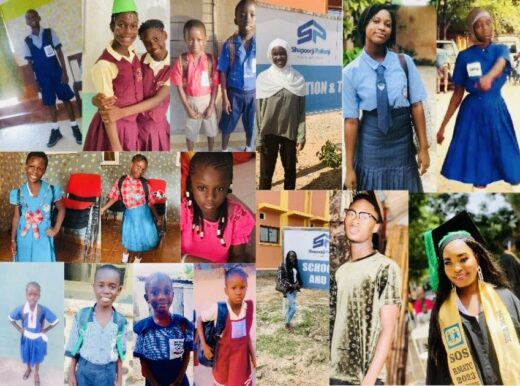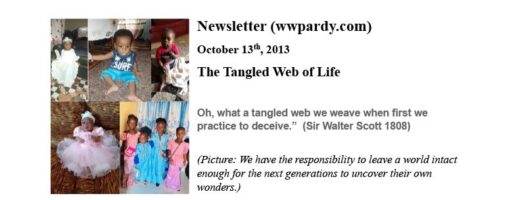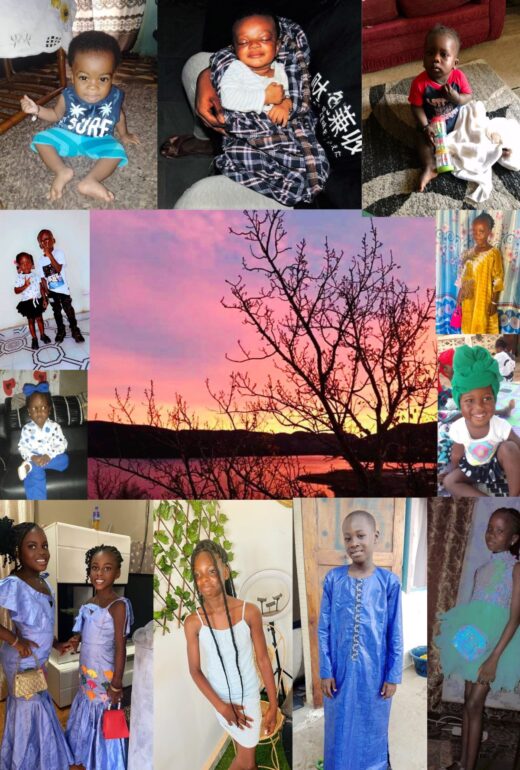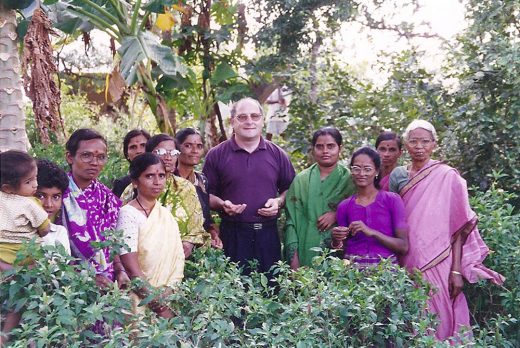
Meeting people and making new friends has been one the treasures of my work and my travels. One such friend, Sam Chelladurai, whom I met at a conference in India, invited me to his home as a means to exchange experiences in community and development.
I have written these notes to share my adventures, experiences and insights. Words barely describe the experience much as pictures rarely portray what one sees. What one feels after such an opportunity is even more difficult to relay.
Hopefully, these musings do give you a flavour of my journey to India which has added to my trips of a lifetime. Of course, all of these travels are only trips of a lifetime because of the many wonderful and warm people that I have been so blessed in meeting along the way. Each one affirming my faith in life, in living and the real and true humanness of people.
The Journey
My travels began from Aberdeen at 6:45 on Wednesday, December 11 1996. I made my way to London, through Dubai and approximately thirty one hours later, arrived in Delhi, India (population 10million). My accommodations at the Delhi YMCA, although Spartan by our standards, appeared to be host to a broad milieu of people. I spent four days in Delhi where I combined touring with exploring development work. I met with two groups, one a church led development agency and the other a NGO (Non governmental agency) – both involved in rural and urban development. My touring primarily focused on Delhi both old and new and an excursion to Agra to see the Taj Mahal.
The next leg of my journey began late afternoon on Monday December 16. I flew to Bangalore (population 4million) where I was met by my friend Sam, with whom I was to stay for most of the next four weeks. His home, was a large house situated in a subdivision outside of Bangalore where a housing boom was happening and house construction everywhere, all apparently with the hope that someone would build roads later. Sam, his wife Lissy and son Jude (eighteen months old) welcomed me as one of their family. Sam, who’s university education included a stint in Nova Scotia studying International development, has devoted most of his life to working with the poor, the lepers and the oppressed. They only had recently moved residence from one of Bangalore’s slum areas where he had been working.
The next four weeks included tours to a number of Development groups within a radius of 250 km from Bangalore and entailed travel by bus, rail and private vehicle. Travel to Sam’s office in Bangalore was accomplished on his elderly 250cc motorcycle. Travel at all times was an adventure as everyone seemed in a hurry, rules were non existent and the choice of vehicles spanned the realm of oxen pulled carts to luxury limousines – albeit most vehicles, even the newer ones, were quite old in design and built very heavy to survive the roads or the lack of same.
The range of development groups whom I visited included those involved in: human rights and justice issues; rural village development; women issues; landlessness; micro finance; the use of mapping techniques as a means to create local awareness; economic research; and information dissemination. I even spent a wonderful day at a Catholic seminary discussing Christian and development issues with a group on young brothers and priests. Most visits were for two to three days with accommodations provided at the various development agency headquarters. The people that run these organisations are most committed, come from diverse backgrounds – many former priests, monks and often have strong Marxist educational or activist backgrounds. They all, without exception were warm, friendly and willing to share, not only their work, but their homes, food and goodwill. I spent many days at Sam’s workplace conversing with his colleagues and his boss, a very interesting individual holding a doctorate in nuclear physics from a U S university. I, as well, paid periodic visits to an ultra modern Cyber cafe situated in the centre of Bangalore. This high tech cafe was a showcase of glass and brass situated amongst the urban decay, rural remains, nouveau shopping and visible poverty of a less than modern but developing city.

Village tours were much a part of my explorations. Typically these rural villages consisted of mud houses with straw roofs, electricity of course which, even in Bangalore, was haphazard at best and off for very lengthy periods each day. The groups were primarily women’s organisations who met in community meeting rooms of varying designs, and where meetings were convened as we all sat in a group on mats on the floor. The groups were all very open, sharing their issues, their bookkeeping systems and their villages. All appeared to be involved in some kind of micro entrepreneurial activities (i.e. raising cows, growing flowers, small shops construction work) All were addressing similar issues as one could expect here – bussing, schools, village halls and of course the position and roles of women in their society. There was considerable need for support on land issues, sanitary services and basics such as the supply of clean water. My last visit was to a centre specialising in Participatory Training Methodologies where I joined thirty plus people (of mixed talents and backgrounds) in a two day workshop dealing with the issues of working with the outcasts (Dalits) in their society.
The last leg of my journey took me back to Delhi for a final wrap up meeting with my new acquaintances in that city, last minute shopping and on the final day attendance at a Sikh festival. This reminded me of a Newfoundland garden party or a Scottish community fun day only at this one 5 million people came. There was no shortage of parades, bands, noise and food that appeared to be distributed to all and sundry. The flight back from Delhi through Dubai, Abu Dubai and London was plagued with delays. As has been the norm over the past couple of years my luggage followed me a day later.
Highlights
The visit to the Taj Mahal which is a wonder to see. The eight hour bus tour added to the wonder as we were treated to the joys of travel on substandard roads with a bus driver who had no fears and a mission to get us there ASAP. If you can imagine, he continually leaned on the horn passing everything in sight and played a constant game of chicken with all oncoming vehicles most of which were heavy goods carriers. The game appeared to be to see who would blink first then give way.
Dinner in Delhi with Dr Dasgupta, who operates a development organisation employing 700 teachers and including his wife, son and daughter. He invited me to his home, where along with his family, a school principal and a government official we debated development issues, present and past approaches, current trends and philosophised how such work might be made better.
The opportunity to stay with a local family, sample the delights of local cuisine, and learn the finesse of eating without the use of utensils. Everyone eats with their hands and at social gatherings and meetings you are usually served food on a clean, wet palm leave laid in front of you as you sit on the floor. Sitting this way was much more difficult to learn than eating with my hands.
Attending mid-night mass on Christmas eve at the seminary cathedral. Everyone sat on the floor men on one side women on the other. The midnight ride to church in a battered van over non existent roads at speeds designed for highways was an adventure in itself. A subsequent visit to the seminary and a tour of the many Christmas church scenes was most rewarding. These scenes included polystyrene models of St Peters Basilica and an oriental Pagoda both of significant size and artistic value.
Decorating the house and sharing Christmas evening with Sam’s work colleagues, friends and neighbours where a variety of Indian delights were served. My western contribution included a plum pudding with butter and brandy sauce.
Awakening on New Years morning to apparent noise and celebration including guns being fired and discovering why our electricity had been cut on New Years eve. No celebrations but, local excitement as we were honoured or threatened (as you may imagine) by a visit of thirty plus wild elephants who had roamed into our area from a national park some ten km distant destroying gardens and knocking aside fences like they were only matchsticks.
My first visit to a village where the villages were getting into business through their own savings and loan set-up and had each bought two cows. The whole village, including the cows came to meet and greet me.

My second visit to a village where I was treated to a cultural evening of song and dance and met a beautiful and colourfully dressed young lass of five who, not only told my fortune, but also danced for me.
Sharing ideas with a development group whose focus was on human rights, and who devoted particular effort to bonded child labour (children practically held in slavery by their employers).
Attending a medical camp and watching two doctors, husband and wife, diagnose and treat approximately two hundred people in approximately four hours. This was the villagers only opportunity to get any medical attention at all.
Interacting with local village groups, all of whom, were noticeably proud of their accomplishments and achievements such as: small savings funds; banishing alcohol from wayward husbands, gaining new prominence for women in their own villages and with government officials; and establishing micro businesses to assist their own economic circumstance. These small ventures included growing flowers, weaving blankets, tending dairy cows, construction, stone cutting and in one instance operating a fair price shop.
A tour provided by one development group to an ancient Fort with a myriad of hidden chambers, breathtaking views followed by a tour of an ancient underground monastery with narrow passages and caverns that reached fifty feet below ground. Six of us went by car over wild terrain on a sunny warm Sunday and I was serenaded along the route by beautiful songs, from Classical to modern Indian numbers by these most talented people.
All my hosts – the development groups were super caring, very warm and most generous. I was made to feel very much part of there efforts, invited to participate, challenged to discuss relevant issues and provided hospitality second to none.
Attending a two day workshops where I had opportunity to learn about the Dalits (outcasts) and the impact of a caste system on human dignity. A powerful opportunity to meet a cross section of development workers and activists from throughout India and to hear their passionate views
Travel -riding buses built for forty but containing perhaps more than one hundred and overnight train trips. The second of which I made alone, and after discovering my ticket was to the wrong destination my fellow travellers, whom I knew not, convened a meeting amongst themselves, spoke to the conductor and subsequently, two stops into the journey, whisked me off the train unto a coach that would take me where I needed to go.
Addressing a formal gathering, via a local translator, at a village regional sporting event and subsequently participating in a discussion with youth (young men) of the village. I informed them that in similar forums in both Canada and Scotland, most likely, there would be a predominance of women. When asked their issues, they responded unemployment and boredom – what you hear here.
Seeing the contrasts between rural and urban settings. Experiencing the flavours of Indian food, culture and mannerisms. Feeling everywhere the warmth and openness of people with so little yet willing to give so much. These feelings are the most difficult to describe much as pictures really can’t express the real images.
Images
Children, some only three or four, all unkempt, even filthy, (pretty little girls and mischievous looking boys) begging on the streets, in amongst the traffic and at horrendous busy intersections. These children have sparkling eyes and often flash wonderful smiles when you contribute. Of course, you will see people everywhere of all ages, some with massive deformities begging for alms.
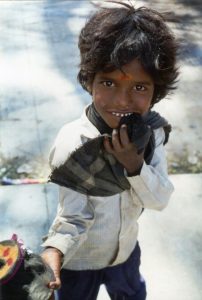
Life and energy, in the midst of decay, litter, and every imaginable and unimaginable type shelter. Despite such hardship, you can see an aliveness and industry that’s inspiring. At six in the morning or at ten at night people are cooking, cleaning, performing physical labour and getting on with their lives, apparently oblivious to their surroundings.
Islands of calm – parks, ruins, temples and open spaces in near proximity to congested, noisy and vibrant neighbourhoods where you could sense and experience what seemingly was complete peace. Difficult to comprehend.
Hustlers or sales experts – within hours of arriving as I made my first exploratory visits on the streets I was accosted by all and sundry such types selling wares of every description. Their intensity was a bit agitating until you grew accustomed to their pushiness and intent to have you purchase at any price.
A beautiful Sikh temple, alongside which, was a shelter that prepared, in huge cauldrons and woks, food three times a day. Everyone rich and poor is entitled to eat there at no cost and I was told that every day they feed thousands.
Leisurely scheduling – a schedule would be set only to get changed within a short time, rearranged, shifted or even cancelled. What was agreed the evening before would take on new dimensions the next day, especially if a new player arrived or something was considered more interesting for you.
Groups of women wearing beautiful multi-coloured sarees wherever I went and realising or should I say noticing when I arrived back in London exposed stockinged legs for the first time in five weeks.
Families – the workers all gathered together along with their families. Events like a first birthday involved a full day celebration with food and fun for all – staff, friends and neighbours.
Dedication – most groups that I met worked every day, seven days a week, lived within their organisational structures or in close proximity. Development work was a mission not really a job.
Vehicles – all kinds, two wheelers, three wheelers (automated ricshaws), cars of old design, trucks with multicoloured paintwork and all manner of decoration. Interspersed into this maze, even in the cities were oxen puled carts, buffaloes and cows wandering everywhere amongst the traffic.
Intersections – no stop signs with right of way seeming to have two criteria size (larger vehicles get priority) and boldness (who was willing to rush forward first into moving traffic).
Narrow bumpy roads – compounded by a continuous game of chicken amongst drivers, challenging who would give way first. Imagine a small taxi and a giant bus or truck barrelling towards each other and just before hitting one or the other moves aside.
Massively overpopulated urban centres and slums beyond description yet, endless miles of underdeveloped and some semi-desert empty land interspersed, with lush developed tracts of farmlands.
Monkeys in great numbers along the sides of the highways and around many buildings.
Coconuts being opened with huge hooked knives to allow you to drink the sweet milk.
Driving along a desolate country road while being serenaded by beautiful melodious voices of my fellow travellers.
Conclusion
I have written these notes to share my adventures, experiences and insights. Words barely describe the experience much as pictures rarely portray what one sees. What one feels after such an opportunity is even more difficult to relay.
Hopefully, these musings do give you a flavour of my journey to India which has added to my trips of a lifetime. Of course, all of these travels are only trips of a lifetime because of the many wonderful and warm people that I have been so blessed in meeting along the way. Each one affirming my faith in life, in living and the real and true humanness of people.
